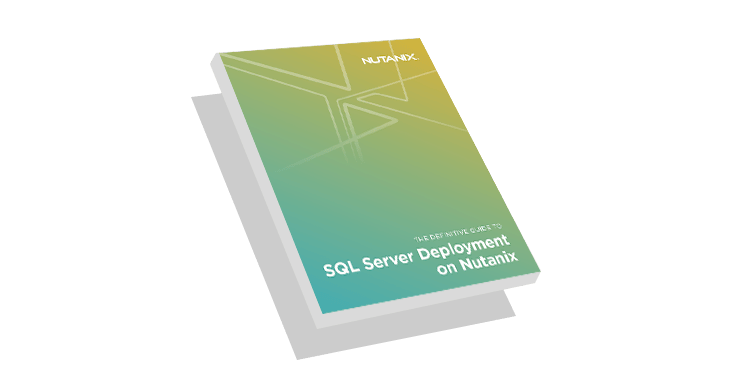Database management is not a singular entity; rather, it’s a series of actions (and for some, a dedicated system) that controls business data during the lifecycle. As data grows, businesses have found that database management is a necessity in manipulating this influx to prevent poor application performance and reduce any impact to compliance and continuity.
There are several techniques and actions under the umbrella of “database management” that a business can take to reduce or prevent the negative impacts of exponential, uncontrolled data growth.
Below is a list of some common, protective database management tasks:
Monitoring the performance of applications and their data and tuning as needed
Planning for storage and capacity growth requirements
Database management helps establish a powerful backup and disaster recovery solution
Archiving, partitioning, replicating, and masking data
Take a Test Drive
Take Nutanix Database Service for a test drive to experience the power and simplicity of the only hybrid multicloud database-as-a-service.

What is a Database Management System (DBMS)?
Whereas database management is a series of best practices, a database management system (DBMS) refers to a software-defined system that manages databases. Common database management systems include Microsoft Access and FileMaker Pro. In this system, users have control over the data in a database and are able to read, update, create, and delete data as needed. A database management system behaves as an interface, offering end users access to their databases and enabling them to organise and access the data as needed.
A database management system is responsible for managing the data, the engine that allows users to access the data within the database, and what is known as the database schema, the organisational structure of a database. Together, a DBMS delivers security and ensures data integrity, but some systems are even used to deliver automated rollbacks and restart, log, and audit activity within a database.
Database management systems can be categorised into various types:
A centralised system where all the data lives in a single location, and users can access that location to manipulate the data.
A distributed system where the data lives in various nodes.
A federated system is able to provision data without source data duplication. This category can be further split into two subcategories:
A loosely coupled database requires access to other component databases.
A tightly coupled database uses independent processes to work into a federated system.
Blockchain database systems manage transactions, financial and otherwise.
How Does Database Management Work?
Put simply, a database manager and their team are responsible for ensuring the health and performance of a business’s databases. Using best practices like the ones outlined above ensures organisational databases run as they should. However, operating with a database management system (DBMS) provides much-needed control and visibility.
In a nutshell, a database management system works as follows: It organises your database files and provides end users more access and control over their data. To accomplish this, A DBMS allows users to manipulate the data in their database files, including creating, editing, and updating it when needed. From there, a DBMS can store and retrieve said data from the database.
Functions of DBMS:
Granting multiple users concurrent access to a single database.
Establishing and maintaining security rules and user access rights.
Backing up data regularly and recovering it quickly should a breach occur.
Setting up database rules and standards to protect data integrity.
Providing “dictionary” definitions and descriptions of available data.
Of course, a DBMS does not replace a database manager or a database administrator. These specialists ensure the database structure runs as it should, and they can create user permissions to control who has access to the data. Together, a DBMS and a specialist can ensure quality control over the data.
The Definitive Guide to Microsoft SQL Server Deployment on Nutanix
Learn how to leverage the performance and management advantages of Nutanix hyperconverged infrastructure (HCI) for your Microsoft SQL solution.

What are the Benefits of Database Management Systems?
The proliferation of data shows no signs of slowing down. As a result, businesses are investing in database management tasks, database managers, and database management systems to do the following:
- Keep business operations running as planned
- Keep track of customers, data inventory, and employees
- Maintain application and database performance
- Store and organise unique, varied types of data
- Automate database processes and procedures
Specifically, the benefits of a database management system are hard to ignore, especially as the amount of data people and machines create every day increases. One of the more notable benefits is improving the security of the data stored in a database. With DBMS, businesses can increase their access to data and help end users throughout the organisations share the data. As a result, these end users can deliver faster sales and make quicker decisions as they have access to the exact data they need.
Furthermore, with a database management system, businesses can eliminate the problems that occur with data inconsistency, which happens if multiple forms of the same data exist in different locations. A DBMS provides organisations a complete, clear view into the way data is shared, ensuring there aren’t unnecessary copies of data. Not to mention, A DBMS allows organisations to enforce data security and privacy policies to reduce the risk of a data breach.
Finally, end users will be empowered to make informed decisions based on the data available. Better, more consistent data means high-quality, usable information that can help users make decisions with the exact data they need. Ultimately, this results in improved productivity throughout the organization.
How to Choose a Database Management System?
Whether your organization wishes to establish database management best practices or adopt a database management system, choosing the right DBMS depends on multiple factors and priorities.
Understanding your existing database(s) is the first crucial step in determining which DBMS will make the most sense. Each database will have its own unique data, so businesses should be knowledgeable about their needs. A good DBMS will deliver a centralised view into the state of your data, so you can see where it is stored and how it is operating. Not to mention, a DBMS will grant access to data across various applications without having to replicate the data first.
It’s also important to keep in mind that like many systems, a DBMS will require more memory and CPU, so businesses should keep in mind if they can support this requirement. However, the benefits of DBMS are tangible, especially when it comes to ever-growing and sensitive data, like those found in healthcare organisations.
Related resources

Nutanix Database Service: Database-as-a-Service Across On-Premises & Public Cloud

Database Solutions Pocketbook

3 Must Haves for Successful Database Management
Related products and solutions
Nutanix Database Service
Hybrid multicloud DBaaS for Microsoft SQL Server, Oracle, PostgreSQL, MongoDB, and MySQL. Efficiently manage hundreds to thousands of databases.
SQL Server
Deliver web-scale engineering and enterprise availability for your database environment.
Oracle
Drive efficiency, agility, and availability in your Oracle environment.
